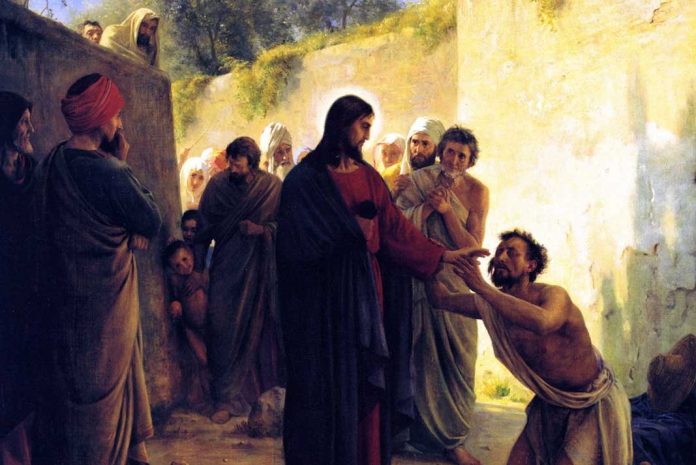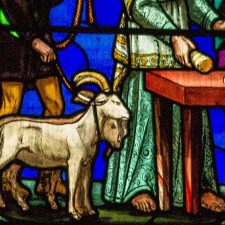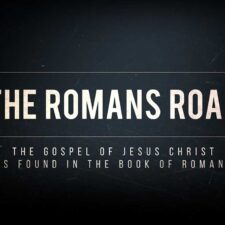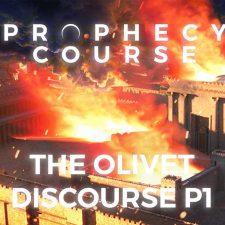To most, the passage in John 9 deals with a blind man being healed by Jesus on the Sabbath, but it is much more about the healing from sin that Jesus accomplished at Calvary. The new covenant is the means by which every believer can find the victorious life and deliverance from the effects of sin which places believers in its bondage. Jesus uses this miracle, the only one in the gospels in which the one healed has been afflicted before birth, to clear up many of the myths that the Jewish mindset embraced regarding the impact of sins on future generations. He also was illustrating the power of the cross in opening the eyes of believers to the mysteries of the kingdom of heaven which God has reserved for new covenant saints (Matthew 13:11).
The Jewish mindset of Jesus’s day recognized a direct link between sin and suffering and was the reason for the disciples’ question when passing this blind man in John 9. Their question was basically asking who was to blame for the man’s blindness, as if every human affliction can be traced to some active failure by someone. Jesus’ answer to the question was telling, “It was neither that this man sinned, nor his parents; but it was so that the works of God might be displayed in him” (verse 3). He was saying that human affliction can have more to do with revealing God’s glory than identifying someone to blame.
The Jewish mindset
The Jewish thought at this time relating to sin and suffering can be summarized as follows:
- The merits or demerits of the parents appear in the children. Certain special sins in the parents would result in particular diseases in the offspring.
- The child up to age 13 was considered to be living in the effects of his father’s sins, suffering for his guilt.
- The thoughts of a mother might affect the moral state of her unborn offspring.
- The terrible apostacy of one of the greatest Rabbis had, in popular belief, been caused by the sinful delight his mother had taken when passing through an idol grove.
- They also adopted the idea from Plato and the Greeks that souls preexist creation in some heavenly place, waiting entry into the body. Although the Greeks saw all souls as good and contamination occurred when entering the body, the Jews believed that some souls were good and some bad.
This mindset is proliferated in the account of Job and his trial. Although Satan was allowed by God to attack Job physically, materially, and personally, Job’s “friends” kept telling him that Job must have done something terribly wrong to be deeply challenged as he was. Job didn’t believe it, but it left him with serious questions about God’s justice – the answer to the question “why”. It wasn’t until after the trial was over and God had restored all that he had lost that we can now understand that his trial was to glorify God, God’s work displayed in him.
Imputed sin
“Therefore, just as through one man sin entered into the world, and death through sin, and so death spread to all men, because all sinned — for until the Law sin was in the world, but sin is not imputed when there is no law. Nevertheless death reigned from Adam until Moses, even over those who had not sinned in the likeness of the offense of Adam, who is a type of Him who was to come.” (Romans 5:12-14)
The Greek word translated “sin” is “hamartia” and it means “an offense in relation to God with emphasis on guilt, to miss the true end and scope of our lives, which is God”, according to Spiros Zodhiates. As Paul relates in Romans 5, the sin nature is a condition of humanity that began with Adam in Genesis 3 (original sin) and has been imputed (transmitted) to each succeeding generation. Each human is born with a sin nature and therefore, sins (Romans 3:10-18). Even during the period before the Law of Moses was introduced, the sin nature was producing death in each person, because all sinned. The ultimate conclusion of this matter is that man is a sinner because of his sin nature and because of the sins he commits and no one other than Jesus is exempt.
In John 9:6-7, Jesus healed the man (on the Sabbath) by spitting on some dirt to create clay, which he rubbed on the man’s eyes. He then told the man to go to the pool of Siloam, the only freshwater basin in the immediate neighborhood in Jerusalem, to wash it off and he “came back seeing”. (This reminds us of Naaman’s healing of leprosy through Elisha by washing in the Jordan River in 2 Kings 5:10-14.) Just as Jesus had healed the man of his blindness, He also heals the sinner of the sin condition by offering a provision for that condition, namely His blood.
Sabbath requirements
Jesus went out of His way to perform this miracle on the Sabbath to once again confront the foolishness of many of the man-made laws (Mishnah) that governed work on the Sabbath. To understand this issue, consider the following beliefs of the Jews during this time:
- Saliva was commonly regarded as a remedy for diseases of the eye, but not a cure for blindness.
- This healing is a manifold breach of the Mishnah since Jesus made clay.
- There was a question about whether any remedy could be applied on the holy day. It could only be done to diseases of the organ (from the throat down) except when danger to life or the loss of an organ was involved.
- It was lawful to apply wine to the outside of the eyelid on the grounds that it was considered washing, but unlawful to apply it to the inside of the eye. Use of saliva on the Sabbath was always considered unlawful.
Jesus was exposing not only the failure of the Mishnah to make a man righteous, but also revealing that He was able to heal without restriction. The healing of a man who was born blind was considered Messianic (see verse 32) since it would require the ability to recreate, and no one but God, Himself could do it. Much of the rest of the account is a lame attempt by the Pharisees to in some way disprove that it really did happen or that Jesus was not from God. They finally got so frustrated with the healed man that they accused him of being “born entirely in sins” (verse 34) and then excommunicated him from the temple.
Spiritual blindness
The account concludes in verses 35-41 with Jesus finding the healed man after hearing about the excommunication and getting the man to recognize Him as the Son of Man, another term for Messiah. The man’s confession of faith, “Lord, I believe” resulted in the man worshipping Jesus and then Jesus spoke of the relationship between blindness and sin. He said to the Pharisees, “If you were blind, you would have no sin; but since you say, ‘We see’, your sin remains”. Jesus had referred earlier in Matthew 15:14, “Let them alone; they are blind guides of the blind. And if a blind man guides a blind man, both will fall into a pit”. Jesus was teaching that the unconverted sin nature causes man to be blind, blind to the sin condition that has plagued the human race since Adam.
Not only is the god of this world, the devil, blinding the minds of all unbelievers to be against Jesus and the gospel, there is a hardening of the heart that burdens all unconverted Jews during the new covenant age, resulting in a veil over their hearts (2 Corinthians 3:14-16). Whenever the Jew recognizes Jesus as Messiah, the veil is lifted and therefore his blindness is resolved in Christ. This warfare is centered on man not seeing “the glory of God in the face of Christ” (2 Corinthians 4:6). When the Light begins to shine in their hearts, meaning the enlightenment of God illuminates the minds of those who seek him with sincerity of heart, then there is a new understanding of the God who leads one to salvation. A great example of this process is seen in the salvation of the apostle Paul in Acts 9:3-6, when a light shone and he was able to hear the Lord speaking directly to his heart in the midst of his blindness.
The effects of idolatry
“’I will lead the blind by a way they do not know, in paths they do not know I will guide them. I will make darkness into light before them and rugged places into plains. These are the things I will do, and I will not leave them undone.’ They will be turned back and be utterly put to shame, who trust in idols, who say to molten images, ‘You are our gods.’ Hear, you deaf! And look, you blind, that you may see. Who is blind but My servant, or so deaf as My messenger whom I send? Who is so blind as he that is at peace with Me, or so blind as the servant of the Lord? You have seen many things, but you do not observe them; your ears are open, but none hears.” (Isaiah 42:16-20)
The context of the above passage in Isaiah 42 is a reference to the coming Messiah, “My Servant” in verse 1. The new covenant provides sight to the blind through a living faith in Jesus as Messiah. This passage reveals that the cause of the blindness and deafness of Israel was their idolatry, creating these idols as “molten images”. When the Lord used My servant in verse 19 as being blind and deaf, He was speaking about Israel. When Jesus is not Lord, other lords will be adopted and the result will be blindness and deafness. James 1:14-15 tells us that the process of sin is to be “carried away and enticed by his own lust. Then when lust has conceived, it gives birth to sin; and when sin is accomplished, it brings forth death.” Human lust patterns are empowered when Jesus is not Lord and the temptation to entertain and act upon those lustful desires becomes overpowering, resulting in sin and unconfessed sin leads to “death”, separation from God (no fellowship).
Son of David, have mercy on me
“35 As Jesus was approaching Jericho, a blind man was sitting by the road begging. 36 Now hearing a crowd going by, he began to inquire what this was. 37 They told him that Jesus of Nazareth was passing by. 38 And he called out, saying, ‘Jesus, Son of David, have mercy on me!’ 39 Those who led the way were sternly telling him to be quiet; but he kept crying out all the more, ‘Son of David, have mercy on me!’ 40 And Jesus stopped and commanded that he be brought to Him; and when he came near, He questioned him, 41 ‘What do you want Me to do for you?’ And he said, ‘Lord, I want to regain my sight!’ 42 And Jesus said to him, ‘Receive your sight; your faith has made you well.’ 43 Immediately he regained his sight and began following Him, glorifying God; and when all the people saw it, they gave praise to God.” (Luke 18:35-43)
Two great examples of this process are covered in Luke’s Gospel as Jesus and the disciples are approaching Jericho (Luke 18:35-43) and then after entering Jericho (Zacchaeus, Luke 19:1-10). This first man, unnamed, was told by the crowd that Jesus was passing by so he cried out, “Jesus, Son of David, have mercy on me!”. This man recognized that Jesus of Nazareth was Messiah and that He was capable of healing him. In verse 42, Jesus acknowledged his faith when He said, “Receive your sight; your faith has made you well.” This man immediately became a follower.
Man’s problem with sin is completely resolved in the work of Christ on the cross. Spiritual blindness is no longer sin’s curse once the believer declares Jesus as Messiah, God in the flesh, and accepts His righteousness in the heart (Romans 10:9-10).













